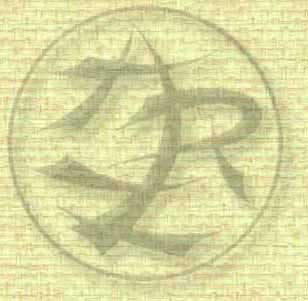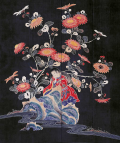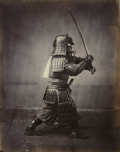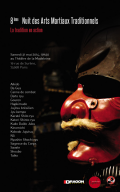
| Home Page > Good tips > Exhibitions - Shows -Concerts > Season 2013-2014 | ||||
| EXHIBITIONS - SHOWS - CONCERTS / SEASON 2013 - 2014 | ||||
Last update: 01/09/2014 |
||||
| From July 10th till October 07th, 2013 | ||||
| TSUTSUGAKI - Textiles indigo du Japon | ||||
| Musée des Arts Asiatiques |  |
|||
| 6, place d'Iéna - 75006 - Paris - France | www.guimet.fr | |||
| ( 00 33 (0) 1 47 23 61 65 | ||||
| Subway: line 9 - Iéna / line 6 - Boissière | ||||
| The museum is open every day except Tuesday, of 10:00 am to 06:00 pm | ||||
| Full price: 4.20 € / cheap rate: 3.20 € (except import duty) | ||||
The tsutsugaki (of tsutsu, “tube” and of gaki, “drawing”) indicates a Japanese technique of dyeing to the indigo accompanied by decorations
carried out by reserve with the rice paste, but more especially works textile which proceed about it, oldest testimonies go back to XVIe century. The fame of the tsutsugaki comes from their nearly invisible assembly
of fabrics, the force of their colours and the quality of their drawings, comparable with true tables to which it would miss only one signature. It is thought that major artists created in their time of the reasons for tsutsugaki. |
||||
| September 01st, 2013 | ||||
| LES TAMBOURS JAPONAIS - Ensemble Yufuin Genryu Taiko | ||||
| Parc Floral - Jardin botanique de la ville de Paris |  |
|||
| Bois de Vincennes - 75012 - Paris - France | www.classiqueauvert.paris.fr/soleil-levant | |||
| ( 00 33 (0) 1 49 57 24 84 | ||||
Subway: line 1 - Château de Vincennes |
||||
| RER: line A - Vincennes | ||||
| Bus: lines n° 46 and 112 | ||||
| Saturday September 01st, 2013 - 04:00 pm - under the Delta | ||||
| Import duties of the Park: Full price: 5.50 € / Cheap rate (7 to 25 years): 2.75 € / Free for less than 7 years | ||||
In Japan, the art of Taiko (drum) is cultivated since millennia. With its sound power, Taiko was used as communications tools while playing a crucial role in the ritual
monks. Musical instrument but also element of spirituality, it holds still today an important function in the Japanese life. There is a considerable number of whole of drums in all the country, each one having its clean
rhythmic dependent on its geographic origin. Regarded as one of best, the whole of drums Yufuin Genryu Taiko, it, come from the island more to the south of the archipelago. It is made up young men who represent
this new generation transmitting the ancestral traditions of Taiko. |
||||
| From February 19th till April 05th, 2014 | ||||
| KAIKO: Sericulture of the Imperial Household Japan | ||||
| Maison de la Culture du Japon à Paris |  |
|||
| 101bis, quai Branly - 75016 - Paris - France | www.mcjp.asso.fr | |||
| ( 00 33 (0) 1 44 37 95 01 | ||||
| Subway: line 6 - Bir-Hakeim | ||||
| RER: line C - Champs-de-Mars-Tour-Eiffel | ||||
| Opening hours Tuesday to Saturday - 12:00 pm to 07:00 pm - Evening Opening Thursday until 8:00 pm - Closed on bank holidays | ||||
| Admission: 5 € / with concession: 3 € - Admission free for MCJP members and children under the age of 12 | ||||
In 1859, after a long period of national isolation, Japan opened the port of Yokohama to foreign trade. As raw silk was an important export product, the silk industry became one
of Japan’s principal industries. To promote the silk industry, Empress Dowager Shoken began raising silkworms in the Imperial Household in 1871. That was the beginning of the Imperial sericulture, and
the tradition has been handed down through the successive Empresses of the Meiji Era (1868-1912), the Taisho Era (1912-1926) and the Showa Era (1926-1989). In spite of the drastic decline of sericulture
in Japan, Her Majesty the Empress has continued to carry on the practice for 25 years in the Heisei Era, and continues to do so to this day, as one of the important Imperial traditions. |
||||
| From March 10th till April 19th, 2014 | ||||
| Didier-LEFEVRE: “AFGHANISTAN 1986-2006” | ||||
| Bibliothèque universitaire du Havre | ||||
| 25, rue Philippe-Lebon - 76600 - Le Havre - France |  ©Succession Didier Lefèvre-2014 |
|||
| ( 00 33 (0) 2 32 74 44 14 | ||||
| Monday at Friday of 09:30 am to 07:00 pm - Saturdays of 10:00 am to 06:00 pm | ||||
Deceased in 2007, Didier Lefèvre was photojournalist since 1984. After having been the photographer of MSF, he was then member of the agency VU before working of independent for Libération,
Le Monde, the Express train, Nouvel Observateur… Its work is characterized by the will to reconsider the same spot in order to follow the evolutions of them. Thus of Afghanistan where it went nine times in twenty years, in order or “speculation” on its equities. The first of these reports in Afghanistan gave place to a cartoon who is from her exit a world success, the Photographer: thirteen translations on all the continents, more than 300.000 specimens sold to date. Under the title “Afghanistan 1986-2006”, they are these twenty years of work accompanied by boards of the cartoon whom the College library will introduce. |
||||
| From Wednesday April 30th till Saturday June 21st, 2014 | ||||
| EVANGELION ET LES SABRES JAPONAIS | ||||
| Maison de la Culture du Japon à Paris |  |
|||
| 101bis, quai Branly - 75016 - Paris - France | www.mcjp.asso.fr | |||
| ( 00 33 (0) 1 44 37 95 01 | ||||
Subway: line 6 - Bir-Hakeim |
||||
| RER: line C - Champs-de-Mars-Tour-Eiffel | ||||
| Opening hours Tuesday to Saturday - 12:00 pm to 07:00 pm - Evening Opening Thursday until 8:00 pm - Closed on bank holidays | ||||
| Admission: 5 € / with concession: 3 € - Admission free for MCJP members and children under the age of 12 | ||||
For this road show presented to Japan and in Europe, Japanese blacksmiths in particular worked sabres, lances and others weapons inspired by Evangelion: New Theatrical Edition,
cartoon with planetary success. These objects with the futuristic forms created starting from ancestral techniques are exposed to the sides of blades and elements of mountings of old sabres. An astonishing fusion between
tradition and science fiction! To make real the fantastic universe of Evangelion is the challenge which took up a score of blacksmiths exerting in various departments of Japan. By using a traditional know-how, they forged the lance of Longinus, the sabre Bizen Osafune, Magoroku Sword and others weapons with the crucial importance in this cartoon which punctuate of the engagements pointing out the battles of medieval Japan. The exposure brings a new lighting on the universe of the traditional Japanese sabres by weaving bonds between past and present. Indeed, in addition to these new creations inspired of Evangelion, are presented a great number of blades and elements of sabres (tsuba, koshirae, tsukamae) dating from the times Kamakura (1185-1333) to Edo (1603-1868). Figurines life size of characters of the cartoon as of the reproductions of the drawn boards supplement the whole for better plunging us in the fascinating world of Evangelion. |
||||
| Saturday May 31st, 2014 - 07:30 pm | ||||
| 8th NUIT DES ARTS MARTIAUX TRADITIONNELS | ||||
| Théâtre de la Madeleine | ||||
| 19, rue de Surène - 75008 - Paris - France | http://theatremadeleine.com/ | |||
| ( 00 33 (0) 1 42 65 07 09 | ||||
| Subway: lines 8 / 12 / 14 - Madeleine | ||||
| Bus: lines 32 / 42 / 45 / 94 / 24 | ||||
| The tradition in action - With exceptional participation of the “Paris Taiko Ensemble” | ||||
| André COGNARD | ||||
| Jacques MUGURUZA | ||||
| Brahim SI GUESMI | ||||
| Allen PITTMAN | ||||
| Ecole LAFOND | ||||
| Jean GONZALEZ | ||||
| Benoît FOLL | ||||
| Kang JONG LEE | ||||
| Paulo-Sergio SILVA DOS SANTOS | ||||
| Philippe COCCONI | ||||
| NAKATA Kenji | ||||
| Jean-Paul BLOND | ||||
| TSUCHIYA Shinya | ||||
| NORO Takeharu | ||||
| IRIE Yasuhiro | ||||
| MATSUURA Masato | ||||
| Farouk BENOUALI | ||||
| Yuan ZUMOU | ||||
| From June 18th till September 22nd, 2014 | ||||
| HARUNOBU, un poète du féminin | ||||
| Musée des Arts Asiatiques |  |
|||
| 6, place d'Iéna - 75006 - Paris - France | www.guimet.fr | |||
| ( 00 33 (0) 1 47 23 61 65 | ||||
| Subway: line 9 - Iéna / line 6 - Boissière | ||||
| The museum is open every day except Tuesday, of 10:00 am to 06:00 pm | ||||
| Full price: 4.20 € / cheap rate: 3.20 € (except import duty) | ||||
HARUNOBU Suzuki, whose work opens out between 1764 and 1770 with the development of the images calendar (egoyomi), is a distinguished figure of the history of the Japanese
print and one of its most singular Masters. Its work establishing the link between the former production of images raised of two colours and those having an enriched polychromy, dissociates that of the artists of the Torii
school characterized by their portraits of actors of kabuki: its work is delayed with the description of subtle female images to delicate polychromy. True pictorial voyage, this presentation of 44 prints evokes the subtle art of Ukiyo-e strongly inspired by the literature and poetry, thus plunging the visitor in the shimmering universe specific to the painter. |
||||
| From June 28th till November 09th, 2014 | ||||
| SAMOURAÏ - 1000 ans d'histoire du Japon | ||||
| Château des Ducs de Bretagne - Musée d'histoire de Nantes | ||||
| 4, place Marc-Elder - 44000 - Nantes - France | www.chateaunantes.fr |  |
||
| ( 00 33 (0) 2 51 17 49 48 | @: contact@chateaunantes.fr | |||
10:00 am with 06:00 pm - closed Monday / from June 27th till August 31st: 7 days/7, 10:00 am to 07:00 pm |
||||
| Full price: 7 € / Cheap rate: 5 € | ||||
The Samurai has been a source of fascination for over 150 years, and is now firmly entrenched in the Western image of Japan. But who were they, really? What do we actually know about
these warriors? When did they first appear in Japanese history? What role did they play in Japanese society? In Japan, from art to the business world, what role do these medieval warriors still have, while their code and
attitudes still pervade Western film and imagination? Bringing together over 450 priceless objects, some of which will be on display for the first time, this exhibition goes beyond the simple historical presentation of a warrior class, and paints a broad portrait of Japan’s past and present. |
||||
| From July 02nd till 06th, 2014 | ||||
| JAPAN EXPO 2014 | ||||
| Parc des Expositions de Paris-Nord Villepinte |  |
|||
| 93420 - Villepinte - France | ||||
On July 02nd: 01:00 pm with 09:00 pm / From July, 03rd to 06th: 09:00 am with 07:00 pm (of 10:00 am to 07:00 pm for the tickets bought on the spot) |
||||
- Wednesday July 02nd: 8 € / Thursday July 03rd: 10 € / Friday July 04th: 15 € / Saturday July 05th: 20 € / Sunday July 06th: 15 € - Fixed price 4 days (of July 03rd): 49 € / Fixed price 5 days: 53 € |
||||
Japan Expo celebrates this year its 15 years! In the centre of the festivities, a retrospective and participative space where each one will be able to remember the past and to discover the history of the festival, and to benefit from the present. All the aspects of the festival are presented on more than 400 m² of exposure: a merry evocation and colour of what makes Japan Expo. |
||||
©ARZ - Academy of Ritsu Zen - Montreuil - France - 2000-2018 - All rights reserved - http://www.arz.asso.fr |
||||
